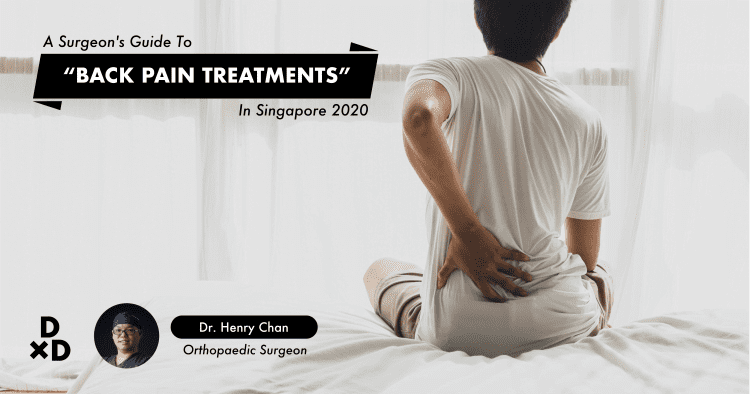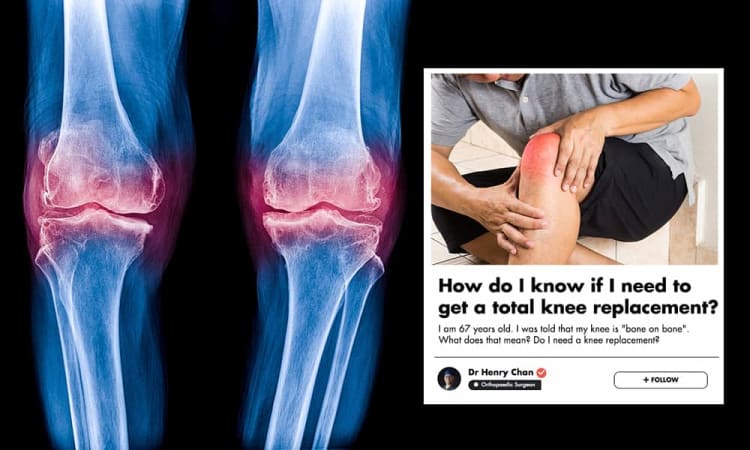Most of the information about knee replacements you find on Google is outdated.
It's no wonder that over my last 13 years as an orthopaedic surgeon, I often encounter Singaporeans who are just downright confused about the entire knee replacement process!
This post will serve as your one-stop destination for all things knee replacement in Singapore. I cover all the most popular questions that patients ask me, such as:
- How much a knee replacement costs in Singapore
- Whether you can avoid having a knee replacement surgery
- What's the best knee replacement procedure
- How to choose the best knee replacement surgeon
It's going to be a long read (2531 words), but hey, I did promise to tell you everything you need to know, right?
First up, what are knee replacements for?

Knee replacements serve 2 main purposes:
- To replace and smoothen damaged cartilage - it's like fixing a new set of tyres for your car to run smoothly again.
- To straighten the leg – bowed or severely deformed legs need to be corrected, just like a building needs to be straightened (Leaning Tower of Pisa aside) to make sure that it doesn’t collapse. This helps to ensure a proper walking posture, and alleviates the stress on your other joints (ie. the hip joints and the spine). [1]
Who benefits the most from a knee replacement?
In a nutshell - those with debilitating knee pain due to arthritis! A knee replacement will vastly improve your quality of life if your current activities are limited by knee pain.
I've seen patients confined to their houses or void decks because of severe pain. It's common for them to rely on strong pain killers to get by, only to end up with stomach ulcers and kidney damage (due to medication side effects). Your knees can be readily replaced, but not your stomach and kidneys!
What happens during a knee replacement?

Orthopaedic surgeons used to rely on their eyes to judge the alignment of the knee replacement.
However, with modern-day robotic technology, much of the guesswork is now replaced with accelerometers/gyroscopes/microcomputers, further enhancing the accuracy and precision of the knee replacements.
The main steps during a knee replacement are as follows:
- Damaged cartilage which causes pain is shaved off
- A smooth metal/ceramic cap is placed onto the surface
- Implants are secured onto the thigh bone and leg bone using cement (the exact same material used by dentists to fill cavities in the past)
- A special plastic component will be inserted in between the two components, which acts as the new “cartilage” and allows pain-free movement of the knee joint
- Adjustment of tension in the ligament to ensure that the knee replacement is stable and well-functioning in all angles of movement. [2]
How much does a knee replacement cost in Singapore?

In government hospitals, knee replacements cost about $20,000 in total. However, you only need to pay about $3000 upfront, as the government provides subsidies of about $10,000 (if you're eligible), and you can claim about $7000 from Medisave.
In the private sector, knee replacements cost about $25,000 to $30,000 in total.
You can also send an enquiry to a few surgeons to get a good sense of the knee replacement costs for your condition.
The high cost of knee replacements is due primarily to the implants used. All the implants used in Singapore are imported from the US - these implants are made of surgical-grade precious metals (cobalt/chrome/steel/titanium/ceramic) which are corrosion-free, strong, and long-lasting.
Bigger, more expensive and more robust implants are necessary for arthritis cases with severe deformity (the supporting structure of the knees are also badly damaged).
The public versus private route for a knee replacement in Singapore
The public healthcare system in Singapore is definitely one of the most reliable and cost-effective systems in the world.
But where costs versus comfort/convenience are concerned, choosing between public or private care is just like picking between a grande iced cappuccino in Starbucks, or having good old Kopi O Kosong in the hawker centre.
Here are the main differences between choosing a public or private hospital in Singapore for your knee replacement.
1. Costs
It's a lot cheaper to have your knee replacement done in a public hospital.
2. Waiting time
The typical waiting time for surgery at a restructured hospital can be about 3 - 4 months.
For private hospitals, you can probably have your surgery within 1 week.
3. Expertise
All restructured hospitals are teaching hospitals that provide training for the next generation of doctors and surgeons.
By receiving subsidies from the government, you agree that your care will be shared amongst specialists, specialist trainees, and non-specialists.
To ensure that you'll always receive specialist care in a restructured hospital, you'll need to pay "private rates" in order to be upgraded to a non-subsidised class (B1 or A class).
4. Environment
In the subsidised B2/C class wards, there's no air-conditioning, and each cubicle has 6 - 8 beds.
If you choose to have your knee replacement done in private, a significant portion of the fees goes towards the facility fees of the private hospitals.
5. Implants choice
Generally, the use of "standard implants" is encouraged in restructured hospitals to save costs.
These implants are like Toyota Corollas - tried, tested, and super reliable. However, standard knee replacement implants may sometimes not be able to meet all the needs of a patient.
Can you avoid having a knee replacement surgery?
Patients often ask me whether they really NEED to undergo knee replacement surgery.
If I were a patient myself, I'd probably wonder the same thing - "Are you sure this surgeon is only telling me to go for this operation because he can earn big $$$$$ for each knee replacement?"
To be clear, knee replacement is an ELECTIVE procedure, meaning that there's no such thing as die-die must do.
If you're only getting occasional knee pains which do not affect your lifestyle, a knee replacement will NOT be required. There are many other options that can relieve mild knee pain, such as viscosupplementation.
However, certain patients can become quite miserable without a knee replacement. Common characteristics amongst this group include:
- Suffering from severe knee pain - this can get REALLY bad. For example, the pain can go on into the night and occur even at rest
- Oral medications such as NSAIDs do not give much relief
- Physical therapy and rehabilitation doesn't work
- Malaligned limbs, which brings us to…
Why do some elderly people walk strangely?
You may have seen some elderly people in Singapore walking with a misaligned gait. They didn’t choose to walk like that, but rather do so because arthritis has eroded the bone and supporting structures of their knees.
Once malalignment occurs, “self-help measures” will not work. This is due to a vicious cycle - malalignment creates more abnormal stress in the knee, which in turn erodes more bone away, creating more malalignment.
As I've mentioned before, knee replacement doesn't just replace the damaged cartilage; it also restores and corrects alignment in the affected limb.
The simplest illustration is a stool with one of its legs crooked. This stool will start to rock whenever you sit on it, and the more you sit on it, the more the legs will get more crooked, which causes it to rock even more. Eventually, the stool will be toppled.
Physically correcting the alignment of the legs enables the stool to be functional again.
What is the best knee replacement procedure in Singapore?
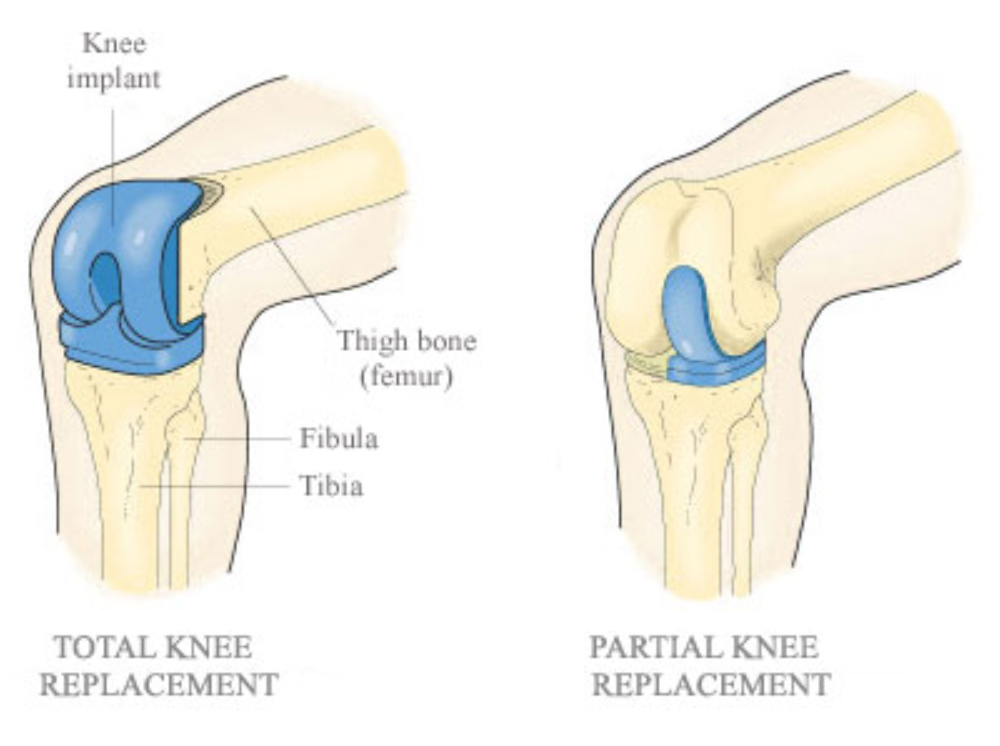
The best knee replacement procedure is one that fits your lifestyle needs. There are two main types of knee replacements:
1. Total knee replacement
As the name suggests, total knee replacement replaces the entire knee joint, including the ligaments in the knee.
It's a very effective surgery with the longest lifespan and has the highest success rate of pain eradication.
However, it's a major surgery which requires a relatively long recovery period. Patients also sometimes feel that their replaced knee doesn't feel very “natural”.
2. Partial knee replacement
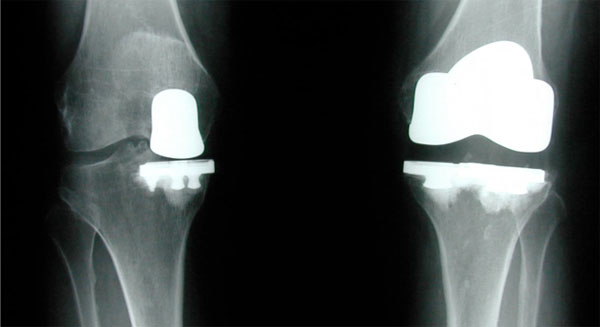
Partial knee replacements only repair the affected area, much like a dentist patching up a tooth with dental caries. Partial knee replacements are reserved for patients without extensive damage to the knee joint. [3]
Since this method removes less bone tissue and cartilage, your surgeon will only need about half the incision area (~10 cm) compared to a total knee replacement.
The benefits of a partial knee replacement include:
- Less pain
- A faster recovery
- Lower risk of complications after the surgery, as compared to a total knee replacement
Patients who have a partial knee replacement may also find that their knee feels more “normal”. This is because the anterior and posterior cruciate ligaments that stabilize the knee joint are kept in place.
However, the disadvantage is that partial knee replacements may not last as long as a total knee replacement, primarily because the non-replaced areas continue to undergo degeneration. This may eventually result in pain again.
How long is the downtime after knee replacement surgery?
A total knee replacement usually requires a 5 day stay in the hospital after the operation. Upon discharge, physical therapy takes another 4 - 6 weeks before you start feeling stable on your legs and relatively pain-free.
With partial replacement, most patients are discharged 1 - 2 days after surgery. Patients generally heal up and can resume their daily activities after about 2 - 3 weeks of physical therapy.
Who is suitable for a partial knee replacement?
In my practice, about 1 in every 3 patients is a candidate for a partial knee replacement.
Criteria that makes you a better candidate for a partial knee replacement include:
1. A localized area of knee damage – if your arthritis is contained to a certain area of the knee.
2. Sedentary lifestyle – if you’re not into sports or don’t exercise all that much, you’re actually a better candidate for a partial replacement. Less wear and tear means a higher probability that the rest of your untouched knee (partial cartilage, ligaments, tendons, etc) will last that much longer.
3. Functional ligaments – since the success of partial knee replacement relies on the structures around the new implant, you’ll almost certainly need a fully intact ACL (anterior cruciate ligament) to be eligible for a partial knee replacement.
The very best candidates for a partial knee replacement have arthritis in only one part of their knee, an intact anterior and posterior cruciate ligament, and a good range of motion or knee flexibility.
What are the advantages of robotic surgery for knee replacements?
Robotic surgery is the latest state of the art technology to be implemented in the medical field.
The main advantage is precision and reproducibility - it's impossible for humans to achieve this kind of precision every single time in surgeries.
With the aid of robotic surgery, surgeons can now make sure that we place the knee implants in the most appropriate position in every patient, every single time.
Robotic surgery involves a pre-operative scan of the knee, which allows the computer to learn about your unique bone structures.
Your surgeon then plans your surgery, making micro-adjustment during the surgery as necessary (we are talking about minuscule adjustments right down to 0.25 mm and 0.1 degrees!)
There is also an added safety mechanism built-in for robotic surgery - a "virtual boundaries set" inside the robot protects your blood vessels and nerves at the back of the knee from accidentally being cut. These are all mapped out by the robot during its pre-operative scan of the knee.
Rest assured that your surgeon is still in full control throughout - the robot will only be activated when the surgeon pulls the trigger. I guarantee that those horror movie scenes like in Terminator or Artificial Intelligence with robots completely taking over the operating rooms will never happen.
I'm pretty certain that robotic surgery is the future, but the main issue now is the cost involved; I expect the price to come down some more in future when it becomes the standard of care.
How much improvement can you expect after a knee replacement operation?
After knee replacement surgeries, there's practically no limit to what you can do. You can:
- Bend your knee (yes! some of my patients actually think that they cannot bend the knee any more after a knee replacement)
- Squat down - dependant on how well you rehabilitate. Some of my patients can even do a full squat after surgery
- Walk upstairs, downstairs, upslope and downslope
- Cycle
- Dance
- Swim (the metal isn’t so heavy that you will sink)
I have even seen patients pursue extreme sports after a knee replacement, such as skiing, snowboarding, water skiing and triathlons!
However, do note that high impact activities (those that require a lot of running and jumping, such as badminton and basketball) may reduce the longevity of implants.
How to get optimal results after your knee replacement
Your rehabilitation is as important as the surgery itself - even if your mechanic has fixed your car to perfection, if you refuse to drive the car, you probably soon won't be able to start the car at all.
It follows that if you decide to stay home, play mahjong all day, and neglect your post-operative rehab, the outcome will be that your knee replacement will not function as well as you hoped.
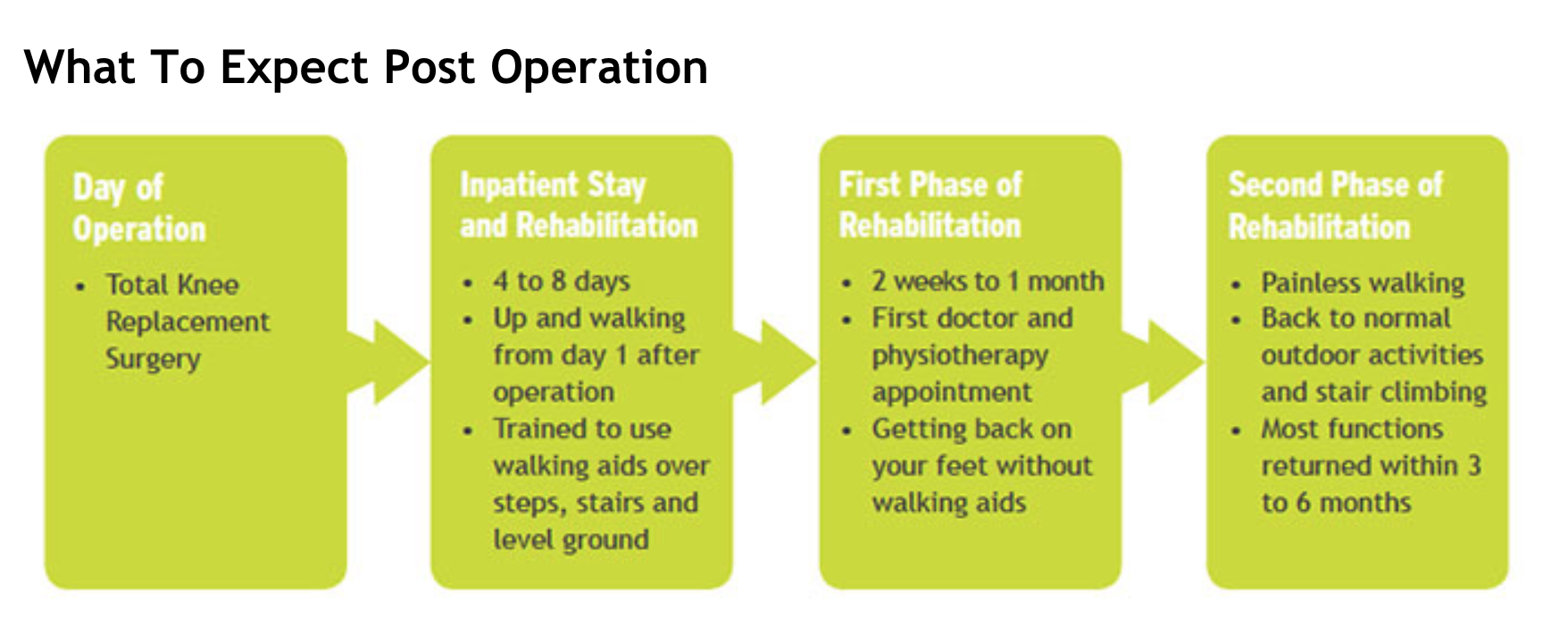
Many patients also ask me whether they should reduce their activities after their operation to prevent "wearing out" their knee replacement. I always challenge them with this analogy -
“You don’t want to drive your new car too much because you are afraid that your tyres will run out faster? Then WHY do you want to buy a car in the first place?"
So if you've got yourself a new ride (or new knee replacement), just go and engage in activities you enjoy. Let the mechanics (or your orthopaedic surgeon) do the rest.
How do you choose a knee replacement surgeon and clinic in Singapore?
When it comes to knee replacement surgeons, the same truth applies - some just do it better too. In the hands of an experienced orthopaedic surgeon, the success rate for a knee replacement is well over 95%.
Surgery is just like everything else - perfection comes with practice; a HIGH volume joint replacement surgeon will usually do a better job. A reputable joint replacement surgeon in Singapore should have done at least 300 joints, and perform a minimum of about 100 - 200 knee replacements per year.
In fact, it is commonplace in other countries for surgeons to publish key data online about their surgical outcomes. This info includes the number of cases they've performed and their complication rates.
Unfortunately, this openness with sharing data doesn't yet exist in Singapore. However, I still think that it's every patient’s right to know this information.
Having back pain? Check out my article on back pain and what you can do about it!
Dr Henry Chan is an orthopaedic surgeon practising at Mount Elizabeth Hospital. Dr Chan specialises in the management of adult and child fractures and trauma, general orthopaedic injuries, sports injuries of the ligament and meniscus, and degenerative spine conditions including prolapsed intervertebral discs (slipped discs). In his free time, he enjoys singing Karaoke.


